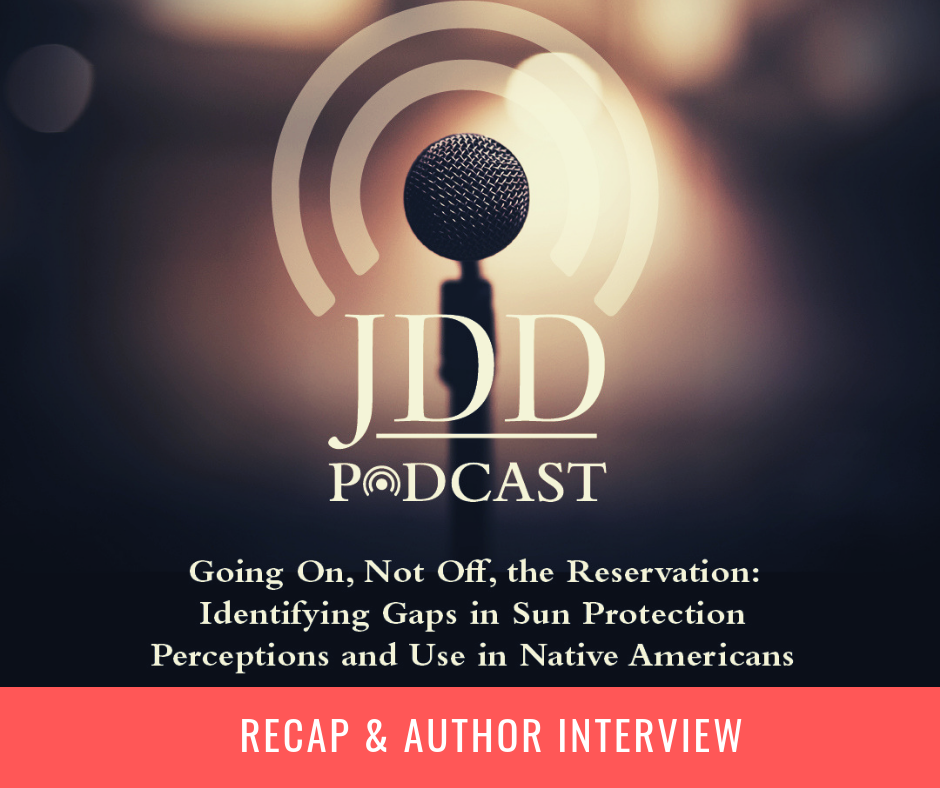Podcast host Dr. Adam Friedman sat down with Dr. Vivian Shi, Assistant Professor of Dermatology at University of Arizona, to discuss skin cancer epidemiology and sun protection behavior among Native Americans. Dr. Vivian Shi’s most recent study published in the June 2019 edition of JDD highlights clear shortcomings in this group. Below are are the podcast highlights.
Key Takeaways
- This study was driven by the practical need to understand knowledge gaps in sun protection behavior among Native Americans, as Arizona where Dr. Shi practices has one of the highest concentrations of Native Americans
- Difficulties with this study included the lack of literature on skin cancer among Native Americans, and a large hurdle was finding people who were familiar with this population and could help gather the data necessary as transportation was difficult, respondents are scattered across a large geographic area, and many people do not have access to the internet or electronic surveys.
- Nearly 90% of participants have been sunburned, significantly more than African Americans. However only 11% of respondents use sunscreen regularly on the body, and 9% never use sunscreen due to the perception that skin cancer doesn’t occur in Native Americans.
- Only 7.5% of participants have had a skin exam though 5% of respondents have a family history of skin cancer. Part of the issue is that most Native Americans receive their health care through Indian Health Services (HIS) and there is limited access to dermatology.
- Compared to the general population, Native Americans are less concerned about cosmetic issues due to sun exposure but are worried about sunburns.
- Education regarding sun protection behavior is very important, including collaborating with primary care providers and providing good counseling in regard to sunburns, skin cancer, and products that are available, affordable, and well tolerated. Tinted sunscreens are more cosmetically acceptable, spray on sunscreens can be less greasy, and roll on sunscreens can be easier to apply.
- Skin checks are not typically part of normal medical evaluations for Native Americans, and Dr. Shi often tries to add it when they are being seen for other chronic dermatologic issues. Learning tribal practices and cultures can also help facilitate a comfortable environment for the patient.
- Teledermatology can help bridge the medical gap, and local programs hopefully can incentivize dermatologists to work with underserved populations, including Native Americans
Make sure to tune in and listen to the podcast here.
Words From The Investigator
I also had the chance to ask Dr. Shi a few questions on her advice to residents and the one book she thinks everyone should read:
How do we close the knowledge gap in regard to sun protection behavior among Native American patients?
Early education in schools and in community events in Native American Reservations, such as Pow Wows. Educating primary care providers to recognize signs of extensive sun damage and stratify risk for skin cancers. Federal programs should incentivize dermatologists to spend time practicing in rural areas including communities serving Native Americans, even if it’s part-time or just a few clinics a month.
What is one piece of advice for current residents and young dermatologists?
Patients are the real experts in their own skin, not us. Hear their story rather than treating them like kodachromes cases. Few patients “read the textbook”, especial patients who are skin of color. As the U.S. population become more ethnically diverse and homogeneous, it is important for us to be equipped in recognizing skin conditions in varying Fitzpatrick skin types.
What is one book everyone should read?
The Hour of the Stars: the Brazilian novel about poverty and social struggle.
Did you enjoy this JDD Podcast Recap? Find more here.

